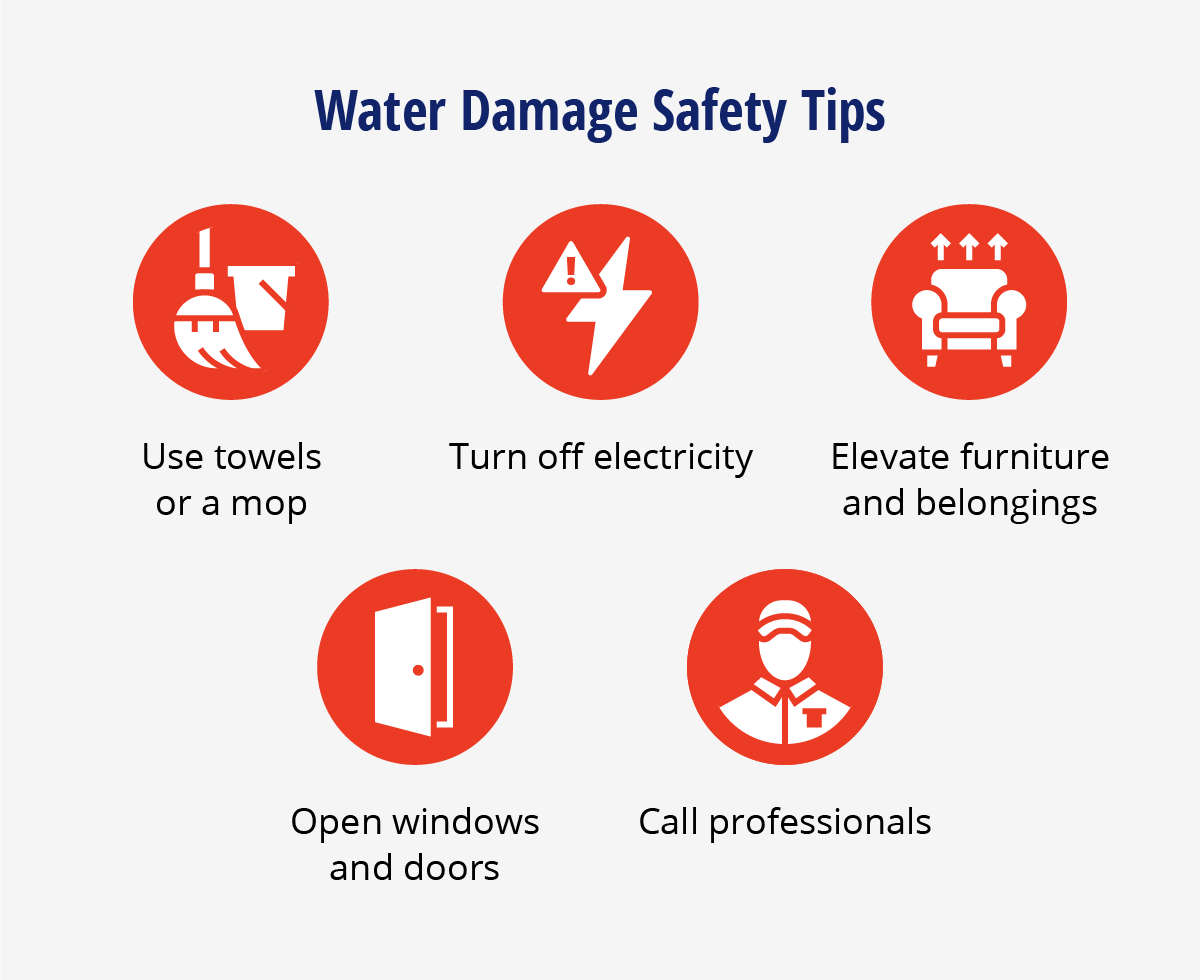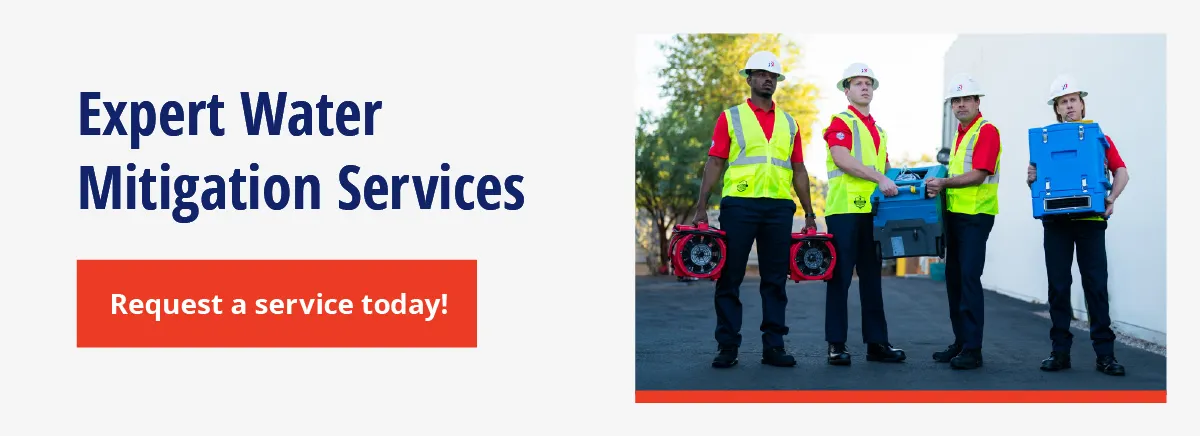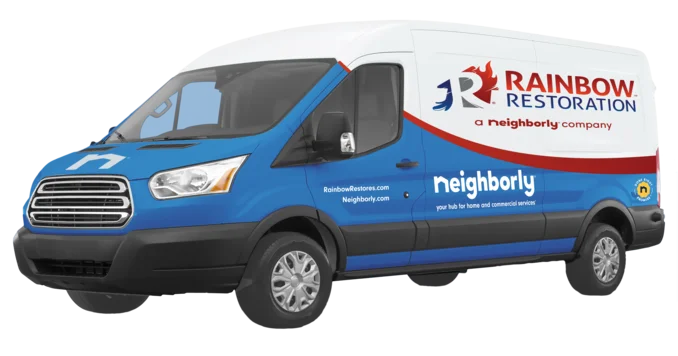.webp)
Rainbow Restoration explains the key differences between water mitigation and restoration, and provides essential steps for addressing water damage.
|
Originally Published: April 8, 2024
From burst pipes to severe weather, water damage is a serious threat that can cause extensive property damage and long-term health risks such as mold growth. When a water loss occurs, professional water mitigation services are essential to reduce the impact and prevent further structural deterioration.
Although water mitigation and restoration are closely connected, these are two distinct phases of recovery that are critical for protecting both property and occupant well-being. Understanding the difference between these processes can help property owners make informed decisions during the recovery process. Here’s what you need to know about water damage mitigation and restoration.
What Is Water Mitigation?
Water mitigation refers to the immediate response taken to prevent further damage after a water loss event. Water mitigation services will remove standing water, dry the affected area, and stabilize the structure.
The water mitigation process typically includes:
- Water extraction using professional-grade equipment
- Industrial dehumidification and drying
- Moisture mapping and monitoring
- Removal of damaged materials that can’t be salvaged
- Containment to prevent mold growth or spread
Unlike restoration, mitigation doesn’t involve repairing or replacing damaged materials. Instead, the process is intended to stop the spread of water and preserve the integrity of the property. If your property has experienced a water loss event, request emergency mitigation services immediately to address water damage before it escalates.
What Is Water Damage Restoration?
Water damage restoration begins after mitigation is complete. This phase involves repairing and rebuilding damaged areas to return the property to its best possible condition.
Common restoration services include:
- Structural repairs to walls, ceilings, and floors
- Replacement of damaged drywall, flooring, and insulation
- Sanitization and deodorization of affected spaces
- Mold remediation, if necessary
Rainbow Restoration® offers comprehensive residential and commercial water damage restoration services tailored to the unique needs of each property.
Water Mitigation and Restoration: Why You Need Both
Water mitigation and restoration are essential to the recovery process. One without the other leaves your property vulnerable—either to ongoing damage or to unsafe, incomplete repair.
For example, if water mitigation is skipped, moisture may remain behind walls or under flooring, leading to mold growth or structural issues. Likewise, if restoration is ignored, the property may become unsafe or uninhabitable.
Working with a full-service water mitigation company ensures both phases are handled efficiently and professionally, reducing downtime and long-term costs.
| Water Mitigation | Water Damage Restoration |
|---|---|
| Immediate response after water damage occurs | Begins after mitigation and focuses on full restoration |
| Minimizes water damage and prevents further harm | Restores property to the best possible condition |
| Focuses on initial cleanup and damage prevention | Comprehensive restoration of property and belongings |
| Water extraction, drying, and moisture control | Structural repairs and contents restoration |
| Short-term process, typically lasting a few days | Long-term process; duration varies based on the extent of damage |
The Value of the Water Mitigation Process
The water mitigation process is critical because it sets the stage for a successful recovery. Proper mitigation helps reduce the scope of damage and shorten the time needed for full restoration.
This phase is time-sensitive. The longer water remains, the more it seeps into materials, damages structural components, and increases the risk of mold. Here’s a breakdown of the essential steps taken by water damage restoration specialists.
- Ensure safety measures are in place: The first priority is ensuring the safety of occupants and restoration professionals, including identifying potential hazards such as electrical issues, structural instability, and exposure to harmful contaminants.
- Determine the extent of damage: A thorough inspection is conducted to assess the class and category of the water damage. This evaluation forms the foundation for a tailored restoration plan.
- Safeguard belongings: Service professionals will carefully protect valuables and belongings. This includes safe removal, assessment, and protective measures to safeguard personal items.
- Remove water physically: Using specialized equipment like pumps and extractors, professionals remove standing water and excess moisture from the affected area.
- Clean and sanitize: Thorough cleaning and disinfection eliminate potential health hazards like mold growth, ensuring that the environment is sanitized and safe for occupants.
- Provide necessary equipment: Next, service professionals use drying equipment, such as dehumidifiers and air movers, to expedite the drying process and prevent further damage.
- Create the right drying environment: Restoration experts control the temperature, humidity, and airflow in the affected areas to create optimal drying conditions and ensure efficient moisture removal.
- Monitor regularly: Lastly, daily monitoring allows professionals to assess the progress of the restoration process and make any necessary adjustments.
.webp)
Choosing the Right Water Mitigation Company
Selecting a reputable water mitigation company is crucial for effective recovery. Look for a provider that offers comprehensive water mitigation services, including emergency response, thorough assessments, and coordinated restoration efforts. A company experienced in both water mitigation and restoration ensures a seamless transition from immediate damage control to complete property recovery.
Understanding the water mitigation process and its role in the broader context of water mitigation and restoration empowers property owners to respond effectively to water damage incidents. By acting swiftly and calling a qualified water mitigation company, you can minimize damage and restore your property efficiently.
Why Choose Rainbow Restoration for Water Damage Services
Rainbow Restoration delivers expert water mitigation and restoration services with a focus on quality, professionalism, and efficiency. Our service professionals are trained to act quickly, communicate clearly, and restore your property with care.
Whether you’re managing a major flood, a burst pipe, or an appliance failure, our team is available 24/7 to help you navigate the process and protect your investment. Learn about our residential and commercial water damage services and solutions to safeguard your property against water damage.
If your property has experienced water damage, do not wait. Contact Rainbow Restoration® for professional water mitigation and restoration services—available 24/7 to help reduce damage and start recovery.
This article is intended for general informational purposes only and may not be applicable to every situation. You are responsible for determining the proper course of action for your home and property. Rainbow Restoration is not responsible for any damages that occur as a result of this blog content or your actions. For the most accurate guidance, contact the Rainbow Restoration location nearest you for a comprehensive, on-site assessment.
FAQ About Water Mitigation and Restoration
Setting the highest standards in water, fire, and mold damage restoration requires a continuous focus and dedication to education and improvement. This commitment to exceptional service also includes using our years of experience and expertise to answer your restoration questions. Here are answers to some of the most frequently asked questions about water mitigation and restoration.
What is water mitigation and why is it important?
Water mitigation refers to the immediate steps taken to reduce and prevent further water damage after a leak or flood. It includes water extraction, drying, and removal of unsalvageable materials. Timely water mitigation is essential to protect your property and lower restoration costs.
What’s the difference between water mitigation and water damage restoration?
Water mitigation and restoration are two parts of the recovery process. Mitigation focuses on minimizing damage immediately after the incident, while water damage restoration involves repairs to return the property to its best possible. Both services are critical and often work hand-in-hand.
How long does the water mitigation process take?
The water mitigation process depends on the extent of the leak or flooding, but typically lasts 1 to 3 days. A professional water mitigation company will assess your situation quickly and begin immediate cleanup to reduce moisture, prevent mold, and protect structural integrity.
When should I call a water mitigation company?
Call a water mitigation company as soon as you notice water damage. Fast action limits long-term issues and accelerates recovery while delaying service can lead to additional repairs and increased costs. Rainbow Restoration provides 24/7 emergency water mitigation services for residential and commercial properties.
Is it safe to clean up a flood myself?
When flooding or other water damage occurs, call a professional water mitigation company immediately. Water damage needs professional attention to ensure a complete recovery. Follow these safety tips to avoid making the situation worse:
- Do not use a vacuum cleaner to suck up water, as it poses an electrocution hazard.
- Avoid wading through floodwaters, especially if they are fast-moving or deep.
- Be cautious of hidden hazards such as sharp objects or debris in flooded areas.
- Do not enter flooded basements or crawl spaces until they have been properly inspected for safety.
- Use a flashlight instead of candles or open flames to avoid fire hazards in flooded areas.
- Seek professional help for thorough cleanup and restoration to ensure safety and proper mitigation of water damage.

Need immediate help with water damage? Call Rainbow Restoration for expert water mitigation and restoration services 24/7.

